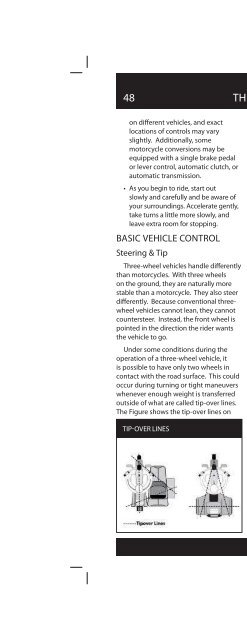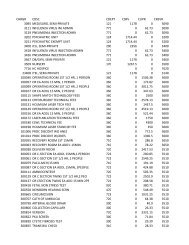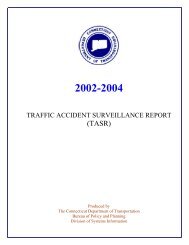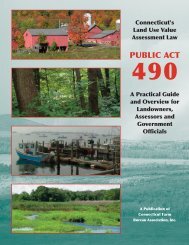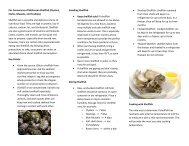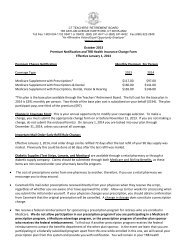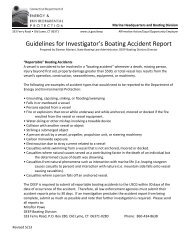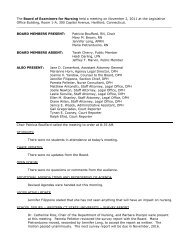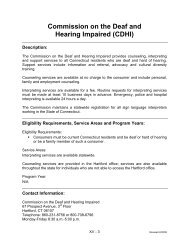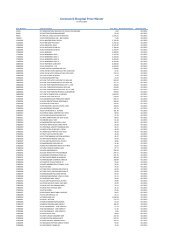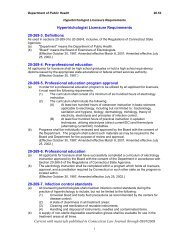The Connecticut Motorcycle Operator's Manual - CT.gov
The Connecticut Motorcycle Operator's Manual - CT.gov
The Connecticut Motorcycle Operator's Manual - CT.gov
You also want an ePaper? Increase the reach of your titles
YUMPU automatically turns print PDFs into web optimized ePapers that Google loves.
48 THREE-WHEEL SUPPLEMENT<br />
on diff erent vehicles, and exact<br />
locations of controls may vary<br />
slightly. Additionally, some<br />
motorcycle conversions may be<br />
equipped with a single brake pedal<br />
or lever control, automatic clutch, or<br />
automatic transmission.<br />
• As you begin to ride, start out<br />
slowly and carefully and be aware of<br />
your surroundings. Accelerate gently,<br />
take turns a little more slowly, and<br />
leave extra room for stopping.<br />
BASIC VEHICLE CONTROL<br />
Steering & Tip<br />
Three-wheel vehicles handle diff erently<br />
than motorcycles. With three wheels<br />
on the ground, they are naturally more<br />
stable than a motorcycle. <strong>The</strong>y also steer<br />
diff erently. Because conventional threewheel<br />
vehicles cannot lean, they cannot<br />
countersteer. Instead, the front wheel is<br />
pointed in the direction the rider wants<br />
the vehicle to go.<br />
Under some conditions during the<br />
operation of a three-wheel vehicle, it<br />
is possible to have only two wheels in<br />
contact with the road surface. This could<br />
occur during turning or tight maneuvers<br />
whenever enough weight is transferred<br />
outside of what are called tip-over lines.<br />
<strong>The</strong> Figure shows the tip-over lines on<br />
TIP-OVER LINES<br />
three-wheel vehicles. Because of this<br />
tendency, careful load and passenger<br />
positioning inside the tip-over lines will<br />
help maintain maximum stability of the<br />
vehicle.<br />
Body Position<br />
As with any motor vehicle, operator<br />
position is important for control and<br />
for reducing or preventing fatigue. <strong>The</strong><br />
operator should be able to reach both<br />
handgrips comfortably, since more<br />
handlebar movement is necessary than<br />
when riding a motorcycle. While it is<br />
not necessary for the rider of a threewheel<br />
vehicle to move drastically during<br />
operation, shifting weight in the direction<br />
of the turn can improve control.<br />
Braking<br />
On a motorcycle with a sidecar,<br />
during braking in a sharp turn, the<br />
sidecar wheel may lift off the ground.<br />
<strong>Motorcycle</strong> and sidecar tires have limited<br />
traction or grip on the road surface and<br />
traction is greater when the vehicle is<br />
rolling, not skidding or slipping. During<br />
turning, some of the available tire<br />
traction is used for cornering, so less is<br />
available for stopping. Thus, a skid can<br />
occur if you brake too hard.<br />
Turning<br />
<strong>The</strong> tendency of the rear, inside wheel<br />
to lift during turning is greater with<br />
increased vehicle speed and tighter<br />
curve radii. During a turn, inertia causes<br />
the center of gravity of the vehicle to<br />
shift sideways, and outward toward the<br />
tip-over line. <strong>The</strong> reduced weight over<br />
the opposite side wheel can cause it to<br />
lift slightly.


